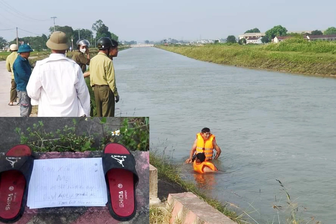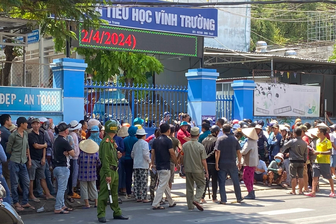Học tiếng Anh mỗi ngày: Những kiến thức cần biết về Câu tường thuật
(Dân trí) - Câu tường thuật là mẫu câu hết sức quen thuộc trong ngữ pháp tiếng Anh. Vậy thế nào là câu tường thuật và chúng thường được sử dụng trong những tình huống cụ thể nào? Hãy cùng tìm hiểu và thử sức với bài tập dưới đây nhé (Phần 1).

Câu tường thuật hoặc câu gián tiếp là câu thuật lại câu nói nguyên văn (câu trực tiếp) được đặt trong dấu ngoặc kép.
Một số thay đổi cơ bản khi viết câu tường thuật
Khi chuyển một câu nói trực tiếp sang câu nói gián tiếp có những thay đổi như sau:
1. Các đại từ:
Về cơ bản, khi tường thuật, các đại từ được thay đổi như sau:
Trực tiếp | Gián tiếp | Trực tiếp | Gián tiếp |
I | she/ he | we | they |
me | her/ him | us | them |
my | her/ his | our | their |
mine | hers/ his | ours | theirs |
myself | herself/ himself | ourselves | themselves |
2. Trạng từ chỉ thời gian:
Trực tiếp | Gián tiếp |
today | that day |
tonight | that night |
now | then, at that time, at once, immediately |
yesterday | the day before/ the previous day |
yesterday morning | the previous morning |
the day before yesterday | two days before |
last (week) | the (week) before, the previous (week) |
ago | before/ earlier |
tomorrow | the next day/ the following day |
tomorrow morning | the next morning |
the day after tomorrow | in two days time |
next (week) | the next (week)/ the following (week) |
3. Đại từ chỉ định:
Trực tiếp | Gián tiếp |
this | these |
that | those |
4. Thì của động từ:
Khi động từ tường thuật (say, tell, ask,...) ở thì quá khứ, động từ trong câu gián tiếp phải lùi một thì so với câu trực tiếp.
Trực tiếp | Gián tiếp |
Hiện tại đơn He said, “I work in a bank.” | Quá khứ đơn He said (that) he worked in a bank. |
Hiện tại tiếp diễn She said, “I am cleaning the kitchen.” | Quá khứ tiếp diễn She said (that) she was cleaning the kitchen. |
Hiện tại hoàn thành “I have done the exercises.” he said. | Quá khứ hoàn thành He said (that) he had done the exercises. |
Hiện tại hoàn thành tiếp diễn He said, “I have been studying for 3 hours.” | Quá khứ hoàn thành tiếp diễn He said (that) he had been studying for 3 hours. |
Quá khứ đơn “I made the birthday cake for him,” she said. | Quá khứ hoàn thành She said (that) she had made the birthday cake for him. |
Quá khứ tiếp diễn He said, “I was sleeping in my room then.” | Quá khứ hoàn thành tiếp diễn He said (that) he had been sleeping in his room then. |
will/shall She said, “I will send you a postcard.” | would She said (that) she would send me a postcard. |
can He said, “I can play the guitar very well.” | could He said (that) he could play the guitar very well. |
may They said, “We may go past your house.” | might |
must/have to (sự bắt buộc) He said, “I must do the duty with care.” | had to |
must (sự suy diễn) | must She said (that) I must be very satisfied. |
must (đưa ra lời khuyên) | must |
must not (sự cấm đoán) | must not |
need He said, “I need to buy a new toothbrush.” | needed/had to He said (that) he needed/had to buy a new toothbrush. |
needn’t (dùng ở hiện tại) He said, “I needn’t hurry.” | needn’t/didn’t have to He said (that) he needn’t/ didn’t have to. |
needn’t (dùng ở tương lai) She said, “You needn’t send the report tomorrow.” | wouldn’t have to She said (that) I wouldn’t have to send the report the following day. |
CÁC TRƯỜNG HỢP KHÔNG THAY ĐỔI THÌ CỦA ĐỘNG TỪ
1. Khi động từ tường thuật (say, tell, ask,...) ở thì hiện tại đơn, tương lai đơn, hiện tại hoàn thành:
VD: He says, “I don’t know the answer to your question.”
→ He says that he doesn’t know the answer to my question.
2. Khi động từ tường thuật (say, tell, ask,...) ở các thì quá khứ, động từ trong câu gián tiếp không đổi thì trong các trường hợp sau:
- Tường thuật một sự thật hiển nhiên, một chân lý, một định luật khoa học
VD: My teacher said, “Russia is the biggest country in the world.”
→ My teacher said that Russia is the biggest country in the world.
- Được tường thuật ngay sau khi nói hay khi thuật lại sự kiện vẫn không đổi
VD: (In class) A: What did the teacher say?
B: He said (that) he wants us to do our homework.
- Khi động từ trong câu trực tiếp ở các thì: Quá khứ tiếp diễn kết hợp với quá khứ đơn, Quá khứ hoàn thành, Quá khứ hoàn thành tiếp diễn, Quá khứ đơn (Đi kèm thời gian cụ thể có thể không đổi thì).
VD: He said, “I was eating when she called me.”
→ He told me he was eating when she called him.
- Khi động từ trong câu trực tiếp có: used to, could, would, should, might, ought to, had to, had better, would rather
VD: He said, “They might win the game.”
→ He said that they might win the game.
- Khi tường thuật mệnh đề ước muốn với “wish, if only”
VD: He said, “I wish I were richer.”
→ He told me he wished he were richer.
- Các câu điều kiện loại 2, loại 3:
VD: He said, “If I had time, I would help you.”
→ He said if he had time, he would help me.
- Cấu trúc “It’s (high/about) time…”
VD: He said, “It’s time we went.”
→ He said it was time they went.
Để tìm hiểu các bài học tiếng Anh khác và bổ sung kiến thức Ngữ pháp, bạn vui lòng xem thêm tại THƯ VIỆN TIẾNG ANH. |
Nhật Hồng (Nguồn Jolo English)























